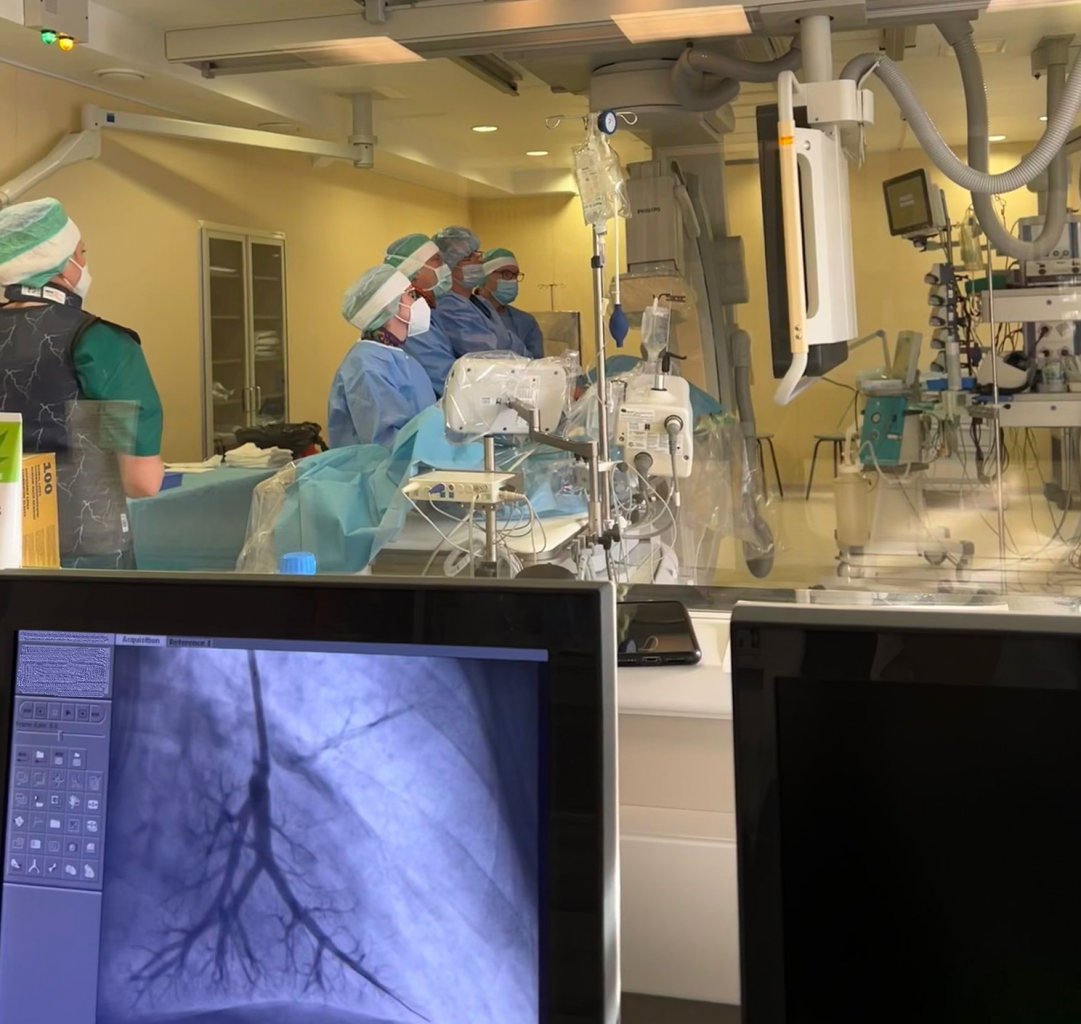PSCUH Introduces New Method for Treating Pulmonary Hypertension in Cooperation With RSU
For the first time in Latvia, Pauls Stradiņš Clinical University Hospital (PSCUH) used a new minimally invasive method, balloon pulmonary angioplasty, to treat patients with thromboembolic form of pulmonary hypertension on 1 April this year.

Picture taken during the surgery.
This was possible thanks to financial support from the Programme of Fundamental and Applied Research Projects at Rīga Stradiņš University (RSU) and the Latvian Council of Science. The new method was introduced in Latvia by cardiologist and RSU lead researcher, Assoc. Prof. Andris Skride together with cardiologist and pulmonary hypertension specialist Dr. med. Ainārs Rudzītis with a team led by an experienced Polish peer Prof. Marcin Kurzyna.
Assoc. Prof. Skride: ‘Pulmonary hypertension is a syndrome characterised by increased blood pressure in the pulmonary arteries, the blood vessels that supply blood from the heart’s right ventricle to the lungs. The higher the pressure in the pulmonary arteries, the more intensively the heart needs to pump to supply blood to the body. Oxygen supply to the body is disrupted and the pulmonary vessels become narrower, which increases risk of thrombosis. The most common symptoms of pulmonary hypertension are shortness of breath, chronic fatigue, chest pains, palpitations, fainting, and blue lips. It is a rare disease and is usually diagnosed at a late stage because of the lack of knowledge about it.
In the severest cases, a patient’s life expectancy is just two to three years if they don’t receive the necessary treatment. Balloon pulmonary hypertension in combination with the proper medicines can treat thromboembolic pulmonary hypertension.’
Balloon pulmonary hypertension, or BPA, is a modern treatment method for treating lesions in pulmonary arteries in specific pulmonary hypertension patients who cannot have surgical treatment of the thromboembolic form of pulmonary hypertension or their pulmonary hypertension is retained also after the surgery. During the procedure, balloons of different sizes are introduced into the pulmonary artery through a catheter and gradually dilate small branches of the pulmonary artery, thus improving blood circulation and reducing the pressure in the pulmonary arteries. Most of patients need to repeat this procedure three to five times until the pressure on the heart muscle that has been caused by pulmonary hypertension is reduced. Balloon pulmonary hypertension improves patients’ general condition, their physical strength, and their heart function.

The first patient was a working 50-year-old man who suffers from massive dyspnoea and heart failure and who needs oxygen therapy. After using the new method, medical practitioners expect his full recovery.
In 2020, the Latvian Council of Science supported a project submitted by RSU “Implementation of balloon pulmonary angioplasty and evaluation of its effectiveness in treatment of chronic thromboembolic pulmonary hypertension at Pauls Stradins Clinical University Hospital”, which started under the leadership of Prof. Aivars Lejnieks. The project included training for invasive cardiologists in performing this procedure, as well as introducing this method to PSCUH, creating an opportunity to create a BPA centre of excellence. Other specialists were also involved in implementing the project: cardiologist Līga Bondare, nurse Aļona Grāve, resident physicians Kristaps Šablinskis, Matīss Šablinskis, Roberts Verners Kalējs, Dana Kigitoviča and RSU students Lelde Loreta Freidenberga and Ričards Kauliņš.
The first data on the effectiveness of BPA were published in 2001, when a group of researchers from Harvard University reported positive results in 18 patients, who experienced reduced shortness of breath and improved physical endurance after the procedure. Since then, this treatment method has been improved upon and developed rapidly to now be used more frequently in the largest pulmonary hypertension centres in Europe, Japan, the United States, and elsewhere.




